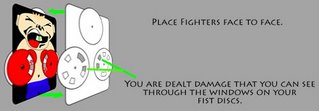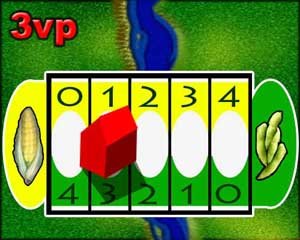Bad Night at Levee Rock
(As with most GDS entries, this is just a rough 1st-pass game outline. So, even though it uses common parts, it has not been playtested, so please…be kind if you do play it.)
The storm of the century is causing the Rolenbohns River to rise, and the five levees that protect the small town of Levee Rock are about to burst. Using the manpower and equipment available to you, can you stop the levees from bursting, and destroying the town?
What you need:
- (approximately) 20-30 Levee Dice (6 sided dice in one color)
- The River (Standard playing card deck)
- (just guessing) 12 Worker Dice (6 sided dice in a different color)
- (maybe) 6 Light Equipment Dice (8 sided dice)
- (possibly) 3 Heavy Equipment Dice (10 sided dice)
- 1 Command Center Die (20 sided die)
What's going on here:
The cards will set water level of the Rolenbohns River at each of the five
protective levees that surround Levee Rock. Levee Dice are rolled, and as the River rises, Levee Dice are removed. If any levee loses all of its
Levee Dice, the levee breaks, the town is flooded, and the townspeople hang you to dry. And, oh yeah, the game is over.
If you can play through the entire deck of cards, the levees have survived the storm, and the town hails you as a hero.
Setup:
Define 5 areas on your table to be Levee Areas, Place 3 Levee Dice at each area.
Shuffle the deck of cards.
Keep your Workers, Equipment, and Command Center near you for the time being (otherwise known as the Command Center).
A turn consists of 5 phases, that occur in the order below:
DIRECT EQUIPMENT AND WORKERS:
You can move Worker and Equipment dice from your Command Center, and between Levee Areas. However, the larger the Equipment, the more time it will take to move.
When moving Equipment, roll the Equipment dice you wish to move, and place it BELOW the River cards in the Levee Area you wish to move them to. These dice are considered to be IN TRANSIT to the desired location. The number rolled indicates how much time it will take to get to the desired location and become ACTIVE.
You may move In Transit Equipment to a new desired location if you wish, but you can only redirent each Equipment once per turn.
Workers move fast, and are never IN TRANSIT. When moving Workers, simply place them above the cards in the Levee Area you wish to move them to. All dice above the River cards are considered to be ACTIVE in repairing and building up the levees.
EQUIPMENT MOVES:
Decrement all Equipment die faces that are In Transit. Once an Equipment Die has been decremented to show a 1, that piece of Equipment has made it to its location; move the die above the River cards to indicate that it is Active.
Roll the Command Center Die. The number rolled indicates the additional amount of “decrements” you can perform on any Equipment die. Again, any Equipment that is decremented down to 1 becomes Active.
REPAIR THE LEVEE:
Roll all Active (above the River cards) Worker and Equipment dice in each area. For every die rolled that is equal to or above 6, add a Levee Die to that Levee Area.
THE RIVER RISES:
In each Levee Area, you will be creating sets of two cards (and leftover
singletons). A set of cards is two cards that match in either rank or suit.
Once a set of cards is made, simply stack the two cards together, and flip them upside down in that area.
So…… for each Levee Area, draw a card; if it creates a set with another
singleton card, then stack the set together, and flip them face down.
Otherwise, leave it in the Levee Area as a singleton to be matched into a
set later.
If a levee draws a joker, remove a set from that levee. When the second joker is drawn, remove 2 sets from that levee.
LEVEE DAMAGE:
At each Levee Area, roll all Levee Dice. Remove any Levee Dice that is
equal or less than the current amount of card sets (not singleton cards) at that area. If all Levee Dice are removed from any one Levee Area, the Levee has been breached. The game is over. Levee Rock is destroyed. Stupid Mother Nature.
Labels: Bad Night in Levee Rock, BGDF, GDS















